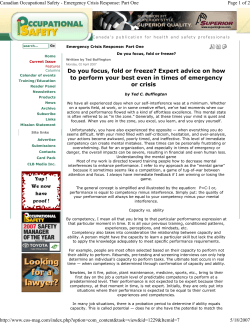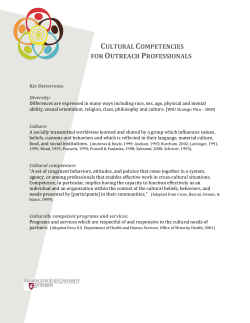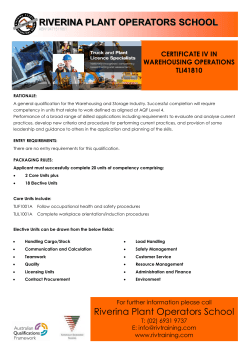
PPT1: How this iMOOC course works PPT2: Anatomy of U.S.
iMOOC: Mastering American eLearning https://www.coursera.org/course/imooc A systematic review of competencies needed for international students and professionals to successfully navigate U.S.-style virtual environments Dr. Val Chukhlomin Dr. Bidhan Chandra Jeannine Mercer 1 The course development team 3 Primary audiences for this course 1. International (non-U.S.) students residing outside of the U.S. and studying online at a U.S.-based college (university) 2. International (non-U.S.) professionals residing outside of the U.S. and working remotely for a U.S.-based company or organization. 3. Incoming to the U.S. international students and first generation immigrants can also significantly benefit from the course 4. It is suitable for undergraduate, postgraduate studies and professional development regardless of academic discipline. 4 5 The structure of the course • M1: Examine barriers to American eLearning • M2: Review technology-related competencies • M3: Learn how to overcome barriers of language and culture • M4: Understand U.S. academic system • M5: Learn how to communicate ideas • M6: Navigate professional contexts • M7: Make sense of self-assessments • M8: Learn how to get U.S. college credit for this course. 6 Module 6 Personal Skills and Attitudes Professional Contexts Module 2 Technology Barriers Module 5 Module 3 Language and Culture Communicating Ideas Social and Academic Systems Module 4 A competency-based approach to bridging AKSA gaps 1. Competency: an ability to perform tasks based on awareness, knowledge, skills and attitudes (AKSA) 2. 5 majors competency areas (technology, language and culture, U.S. academic systems, communications and professional contexts) 3. To overcome barriers and master American eLearning, non-native students need to develop a set of competencies; 4. Barriers are conceptualized as AKSA gaps; to help students detecting gaps, we use a self-diagnostic tool designed for this course. 8 Self-Management Self-Regulation Leadership Teamwork Professional contexts Legal environment Frameworks Prerequisites Ethics Communities Computermediated communication Academic writing Style manuals Presentations Discussions Academic integrity Self-Directedness Motivation Personal skills and attitudes Professional Contexts Technology Key Competencies Language and Culture Communicating Ideas Social and Academic Systems U.S. Education Transcripts, credits Policies, procedures American classroom Roles, expectations Grading, exams Hardware Software E-Communications Intranet LMS Academic Support E-library Online learning centers Web conferencing English American English Slanguage Professional language National culture Organizational culture Local contexts Conflict resolution iMOOC • Focuses on overcoming barriers • Uses competency-based approach • Provides a framework of competencies needed to overcome barriers and become proficient • Works primarily as a self-diagnostic tool • Is part of a larger effort – iMOOC as a hub; then, xMOOC, ESC (SIL, IeLS, and TIS), orientations by SUNY campuses, partner university credit-bearing courses abroad; – Refer students to external resources including other MOOCs. 10 Introducing iMOOC: Working with partner universities across the globe • Ways of using the course (xMOOC, cMOOC, sMOOC) • What is an iMOOC? - An integrated MOOC which includes: A traditional MOOC (xMOOC or cMOOC) A self-paced, on-demand MOOC (sMOOC) Linked to orientation courses offered by U.S. universities Linked to for-credit courses offered by U.S. universities Linked to for-credit courses offered by partner universities abroad • Benefits for partner universities and organized groups • How to become a partner university? Expected learning outcomes • Recognize 6 key competency areas (domains) that a non-native student (professional) needs to master in order to seamlessly navigate U.S.-style virtual environments; • For each competency area, systematically review competency sets (“competency units and elements”) and examine levels of proficiency in terms of required knowledge, skills and attitudes; • Recognize how gaps in knowledge, skills and attitudes form barriers to effective learning and work in U.S.-style virtual environments continued on the next slide 12 Expected learning outcomes (continued) • Identify remedial resources, strategies, best practices and skill-building techniques and discuss those with peers across the globe; • Self-assess your perceived level of mastery of each competency unit (element); identify gaps in knowledge, skills and attitudes and develop personal strategies for improvement; • As a result, perform more effectively in U.S.-style virtual environments, develop self-directed study skills and enhance employability skills. 13
© Copyright 2025





















